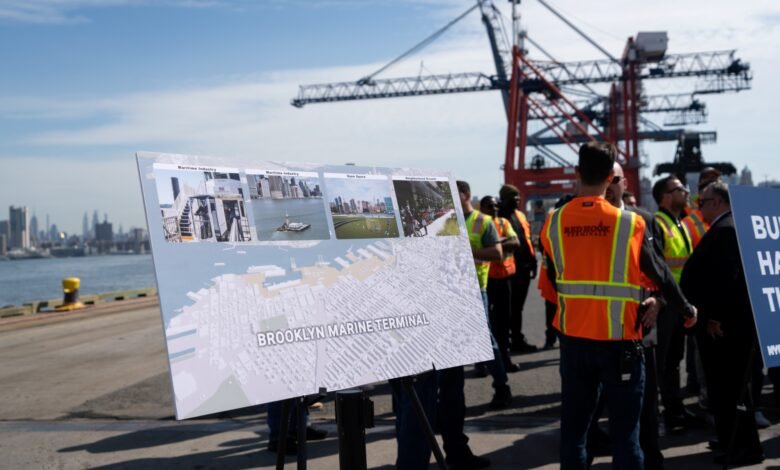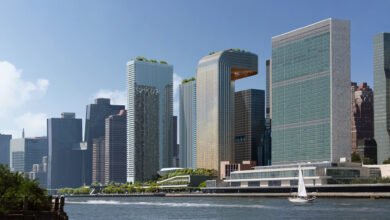$3.5B Brooklyn Marine Terminal redevelopment moves forward


A plan to redevelop 122 acres of Brooklyn’s industrial waterfront—adding thousands of apartments and a modern port—just cleared a major hurdle. A task force overseeing the $3.5 billion redevelopment of the Brooklyn Marine Terminal on Monday voted to advance the project, which includes a 60-acre all-electric port, 6,000 new apartments, and 28 acres of open space from Cobble Hill to Red Hook. The vote followed five previous postponements and comes just before the deadline to secure city and federal funding, according to The City.

The redevelopment plan, led by the city’s Economic Development Corporation (EDC), is the largest real estate transaction of its kind in 20 years. In May 2024, Mayor Adams announced an agreement with the Port Authority of New York and New Jersey to take over the land—stretching just over a mile from the southern edge of Brooklyn Bridge Park to Red Hook—in exchange for the 225-acre Howland Hook Marine Terminal in Staten Island.
Backed by $410 million in city, state, and federal funding, the proposal aims to restore the dilapidated marine terminal while adding 6,000 new homes—including 2,400 permanently affordable units—28 acres of public space, 250,000 square feet of community facilities, and 225,000 square feet of industrial space.
The plan will transform the marine terminal, once a key component of the city’s economy, into a 60-acre sustainable port, with a new marginal pier for water-to-water freight and on-site cold storage facilities that will reduce trucks on local roads, easing traffic, pollution, and other quality-of-life concerns.
The Brooklyn Cruise Terminal will also be upgraded, with redevelopments adding public open space, industrial and commercial areas, and a 400-key hotel, transforming the areas around Piers 11 and 12 into a community-accessible waterfront destination.
Public transit and the streetscape will also be upgraded, with faster buses via priority lanes, expanded ferry service, a $50 million electric shuttle program, pedestrianized streets, and other improvements. The MTA will evaluate the feasibility of restoring legacy bus routes like the B71 or enhancing and creating new services for better inter-neighborhood transit.
City officials also expect the project to generate $18 billion in economic impact, create 37,000 temporary construction jobs and 2,000 permanent positions, and deliver vital infrastructure upgrades.
To move forward, the 28-member Brooklyn Marine Terminal Task Force—chaired by Rep. Daniel Goldman, Sen. Andrew Gounardes, and Council Member Alexa Avilés—had to approve the proposal. Passage required a two-thirds majority, a threshold that was difficult to reach and delayed the vote five times over the past year.
At the time, Avilés told The City that city officials “force-fed” the proposal to residents, and some task force members hesitated to approve a plan she said lacked sufficient exploration.
Local residents also criticized the EDC for failing to address whether a large housing development in a flood-prone area without subway access is feasible, and whether schools and sewage systems could accommodate the arrival of new residents.
Borough President Antonio Reynoso and Council Member Shahana Hanif switched from opposing to supporting the plan after city officials secured key changes, including increased funding for affordable housing and a commitment to explore and share ways port operators and maritime businesses could use the terminal.
With approval secured, the EDC will establish a Brooklyn Marine Terminal Advisory Task Force to oversee the project during environmental review and the development of the general project plan.
Rep. Dan Goldman celebrated the approval in a statement, calling it a “historic step.”
“For the first time in two generations, the Brooklyn Marine Terminal is on track to once again become a vital and vibrant economic, maritime, environmental, and community asset,” Goldman said. “For decades, the port and surrounding area was allowed to fall into disrepair, and every attempt to revitalize it failed.”
He added: “Today, we have taken a truly historic step forward in finally realizing a plan that will save, modernize and expand the port, create an industrial and commercial hub for the future, address climate change and spearhead the blue highway, connect our neighborhoods to the waterfront, and build thousands of affordable homes to tackle the housing crisis.”
The EDC will work with the community and the task force to refine the site plan ahead of its draft environmental impact statement and Empire State Development’s adoption of a draft general project plan in 2026.
The agency hopes to release the first request for proposals for a long-term port operator by the end of 2026.
RELATED:
Source link




